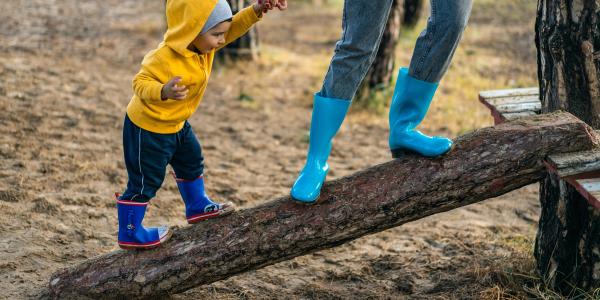Eight Ways to Encourage Math Learning During Risky Outdoor Play

Full-day kindergarten teacher, researcher, and writer Deanna Pecaski McLennan explains how risky outdoor play can contribute to children’s mental and physical growth while empowering them with authentic opportunities for math learning. Her piece complements the theme of Teaching Young Children’s Spring 2023 issue. Visit NAEYC.org/tyc/spring2023 to learn more about fostering young children’s health and nutrition.
In my 22 years as an early childhood educator, I have found that children’s risky play is filled with rich mathematical possibilities. Empowering children to challenge themselves outdoors builds their physical and mental stamina while encouraging authentic math learning. Risky play involves a chance to experience excitement or thrill as well as challenges, fear, and/or potential injury. It also promotes creativity, teamwork, perseverance, managing different emotions, physical development, and safety. Early educators communicate to children that they are resilient and capable when providing risky outdoor play opportunities.
A simple, natural object like a tree stump can create rich opportunities for early math learning and risky play. For example, I’ve observed children discussing balance, height, length, and time as they climbed up and jumped off tree stumps. They counted how many children were in line for a turn and monitored their place in it. They also created a system for measuring the height and distance of each child's jump. Finally, they strategized how to improve their performance and how to create increasingly difficult obstacle courses using additional stumps. It was child-centered, authentic, and deeply connected to their immediate world.
Here are eight ways to encourage children’s math learning during risky play outdoors.
1. Incorporate math tools into children’s explorations. Math tools, like timers, trundle wheels, compasses, and scales, can be introduced as children explore meaningful problems related to their lives. You can model and invite children to use tools in specific contexts, such as demonstrating how to weigh found objects outside. You can also provide time and space for children to freely explore these tools during risky outdoor play.
2. Promote spatial reasoning and logic. Outdoor play promotes spatial awareness, which is the ability of children to be conscious of their body position in relation to their surroundings. It’s not only important to navigate the present, but it also supports future success in math. Awareness of location helps children figure out and describe where something is (above, below, adjacent, behind), and awareness of movement helps them to understand how an object or person travels through space and time (fast and slow). You can model language related to location and movement, ask questions, and give verbal and nonverbal hints and cues to help children start to use these skills.
3. Integrate number sense and data. Children are often eager to mathematize their outdoor play by calculating how fast, how far, how long, and how high they have moved. Recording and comparing these measurements makes use of sophisticated math concepts. You can provide resources and scaffold children in gathering data. For example, you can chart the height a child has jumped or enter the time a child ran a certain distance on paper or in a spreadsheet. You can then guide them to analyze changes in these numbers over time.
4. Point out cause-and-effect relationships. Understanding cause and effect is important in math and other content areas. Sometimes cause-and-effect situations are purposeful and planned, such as setting up a simple catapult made from a wooden board and a roller and seeing how high an object flies when a child stomps on one end of the board. Other times, it can be spontaneous, such as a child jumping in a puddle and splashing their friend. During these activities, children practice problem-solving to refine their results. They test different actions, compare outcomes (how far, how fast, how high), and modify. Educators can make math visible by noticing and naming children’s thinking and actions. For example, discussion starters like “I noticed the harder you stomped on the catapult, the higher the object moved” can make the math explicit.
5. Embed other content areas. Risky outdoor play can foster knowledge and skills across the curriculum. For example, building complex structures and creating obstacle courses involve math and other areas of STEM (science, technology, engineering, math). Children can integrate many natural and human-made objects into their structures and courses, including stumps, branches, rocks, hills, beams, pylons, hula hoops, and flags. After building complex structures and runs, children can maneuver their bodies and play within their creations. You can integrate other content areas by asking children what they are curious about and what they already know about a topic. Then, you can introduce and scaffold content-specific concepts and skills to grow the experience.
6. Observe and nurture mathematical curiosity. Children often become curious about something that happened during risky play outside. Because these aren’t necessarily planned, giving time and space to be curious is important. Once a mathematical curiosity emerges, you can act as a guide, helping children plan, design, and research their areas of interest. Some inquiries may take place over a short period of time (discussing who can throw the ball the highest), or they can take days or weeks (designing and building a pulley system to lift a bucket of rocks).
7. Facilitate teamwork. Working together during risky outdoor play helps children use their immediate surroundings to practice problem solving, self-regulation, and collaboration, all of which are important for future math learning. For example, if a tree branch is too high for a child to reach on their own, a peer might offer a boost or help them roll onto a stump to use as a stool to climb.
8. Foster a growth mindset in children. Many feats children want to accomplish during risky play—climbing up a rope, riding a two-wheeler, and balancing while walking on a wooden beam—take time, support, perseverance, and practice to master. Children can learn these qualities as they accomplish their goals during risky play. They can also apply them when faced with challenges during math experiences and take pride in their achievements.
To learn more about facilitating risky outdoor play, read Ron Grady’s Climbing Trees, Risk, and Relationships: Using Nature to Empower Children | NAEYC.
Deanna Pecaski McLennan, PhD, is a kindergarten educator and author in Windsor, Ontario, Canada. She loves exploring mathematics through a play-, inquiry-based approach. She enjoys sharing her classroom practice and connecting with others using social media. @McLennan1977
